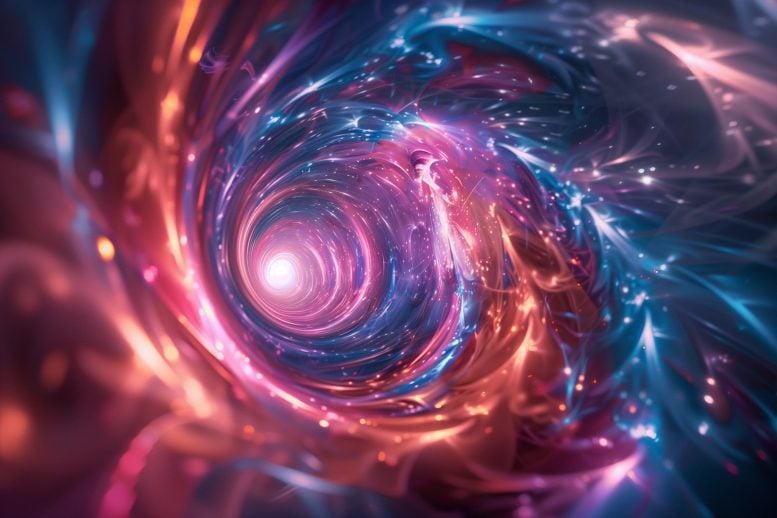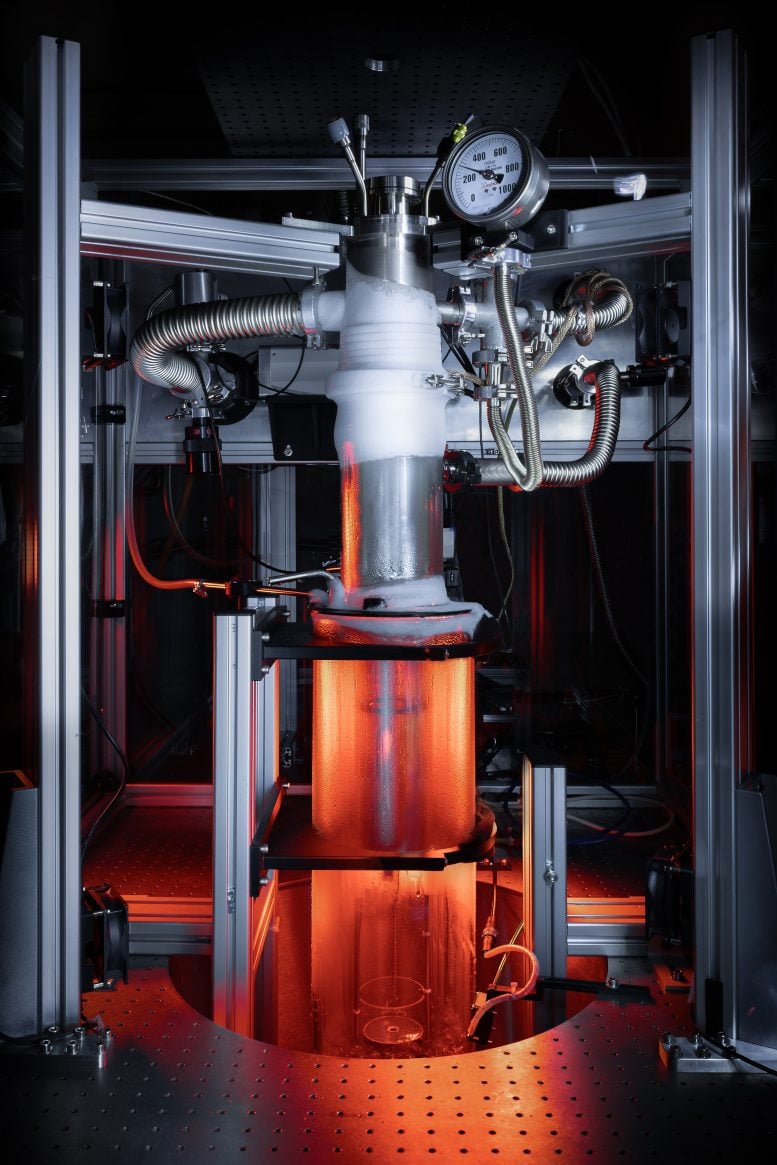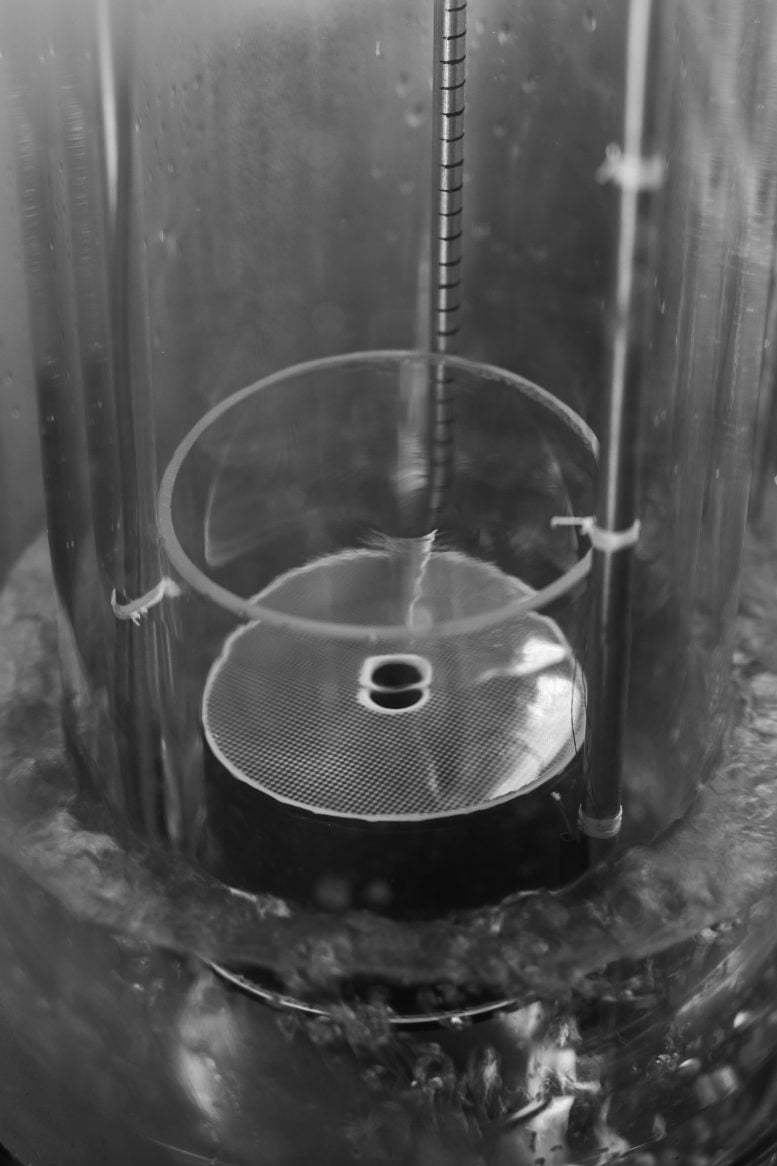
Researchers have created a quantum tornado in superfluid helium to simulate black hole conditions, advancing our understanding of black hole physics and the behavior of quantum fields in curved spacetimes, culminating in a unique art and science exhibition.
Scientists have, for the first time, created a giant quantum vortex in superfluid helium to mimic a black hole. This breakthrough has enabled them to observe in greater detail how analog black holes behave and interact with their surroundings.
Research led by the University of Nottingham, in collaboration with King’s College London and Newcastle University, has created a novel experimental platform: a quantum tornado. They have created a giant swirling vortex within superfluid helium that is chilled to the lowest possible temperatures. Through the observation of minute wave dynamics on the superfluid’s surface, the research team has shown that these quantum tornados mimic gravitational conditions near rotating black holes. The research has been published today in Nature.

Lead author of the paper, Dr Patrik Svancara from the School of Mathematical Sciences at the University of Nottingham explains: “Using superfluid helium has allowed us to study tiny surface waves in greater detail and accuracy than with our previous experiments in water. As the viscosity of superfluid helium is extremely small, we were able to meticulously investigate their interaction with the superfluid tornado and compare the findings with our own theoretical projections.”
Advanced Cryogenic System and Quantum Insights
The team constructed a bespoke cryogenic system capable of containing several liters of superfluid helium at temperatures lower than -271 °C. At this temperature liquid helium acquires unusual quantum properties. These properties typically hinder the formation of giant vortices in other quantum fluids like ultracold atomic gases or quantum fluids of light, this system demonstrates how the interface of superfluid helium acts as a stabilizing force for these objects.
Dr Svancara continues: “Superfluid helium contains tiny objects called quantum vortices, which tend to spread apart from each other. In our set-up, we’ve managed to confine tens of thousands of these quanta in a compact object resembling a small tornado, achieving a vortex flow with record-breaking strength in the realm of quantum fluids.”

Linking Quantum Vortices to Black Hole Physics
Researchers uncovered intriguing parallels between the vortex flow and the gravitational influence of black holes on the surrounding spacetime. This achievement opens new avenues for simulations of finite-temperature quantum field theories within the complex realm of curved spacetimes.
Professor Silke Weinfurtner, leading the work in the Black Hole Laboratory where this experiment was developed, highlights the significance of this work: “When we first observed clear signatures of black hole physics in our initial analog experiment back in 2017, it was a breakthrough moment for understanding some of the bizarre phenomena that are often challenging, if not impossible, to study otherwise. Now, with our more sophisticated experiment, we have taken this research to the next level, which could eventually lead us to predict how quantum fields behave in curved spacetimes around astrophysical black holes.”
Reference: “Rotating curved spacetime signatures from a giant quantum vortex” by Patrik Švančara, Pietro Smaniotto, Leonardo Solidoro, James F. MacDonald, Sam Patrick, Ruth Gregory, Carlo F. Barenghi and Silke Weinfurtner, 20 March 2024, Nature.
DOI: 10.1038/s41586-024-07176-8
This groundbreaking research is funded by a £5 million grant from the Science Technology Facilities Council, distributed among teams at seven leading UK institutions, including the University of Nottingham, Newcastle University and King’s College London. The project has also been supported by both the UKRI Network grant on Quantum Simulators for Fundamental Physics and the Leverhulme Research Leaders Fellowship held by Professor Silke Weinfurtner.
The culmination of this research will be celebrated and creatively explored in an ambi exhibition titled Cosmic Titans at the Djanogly Gallery, Lakeside Arts, The University of Nottingham, from 25 January to 27 April 2025 (and touring to venues in the UK and overseas). The exhibition will comprise newly commissioned sculptures, installations, and immersive artworks by leading artists including Conrad Shawcross RA that result from a series of innovative collaborations between artists and scientists facilitated by the ARTlab Nottingham. The exhibition will marry creative and theoretical inquiries into black holes and the birth of our Universe.
3 Comments
Isn’t it about time we started calling these things “African American holes”?
Researchers at the University of Nottingham, along with King’s College London and Newcastle University, have created a quantum vortex within superfluid helium to simulate black hole conditions. This experimental setup allowed them to study tiny surface waves and their interactions in superfluid helium, revealing how these conditions resemble the gravitational forces near black holes, offering insights into quantum fields in curved spacetimes.
Very good!
Please ask researchers to think deeply:
1. What is the physical reality of quantum?
2. Are quantum vortices related to topological vortices?
3. Can quantum spin?
4. If the so-called quantum can spin, where does its force come from?
5. Is spin a wave or a particle?
6. Can entanglement of multiple spin waves form particles?
7. Is the spacetime vortex a topological vortex?
8. Does space have ideal fluid physical characteristics?
9. Can an ideal fluid form topological vortices?
10. Does topological vortex occupy space?
11. Can topological vortices be used for timing?
12. Can the synchronous effect of topological vortices form the Quantum “Tornado”?
and so on.
cientific research guided by correct theories can help humanity avoid detours, failures, and pomposity. Please witness the exemplary collaboration between theoretical physicists and experimentalists (https://scitechdaily.com/microscope-spacecrafts-most-precise-test-of-key-component-of-the-theory-of-general-relativity/#comment-854286). Is this the children’s story of contemporary physics?
Misguided by the pseudo-scientific theory of Physical Review Letters (PRL), many researchers do not consider the similarities and differences between geometric shapes and physical reality in physics research, but indulge in imagination. Although scientific research can be imagined, it cannot be done recklessly.
Contemporary physics has always lived in a self righteous children’s story world. Whose values have been overturned by such a comical and ridiculous reality?
Please continue performing, there will always be an audience willing to watch these dirty and ugly things.